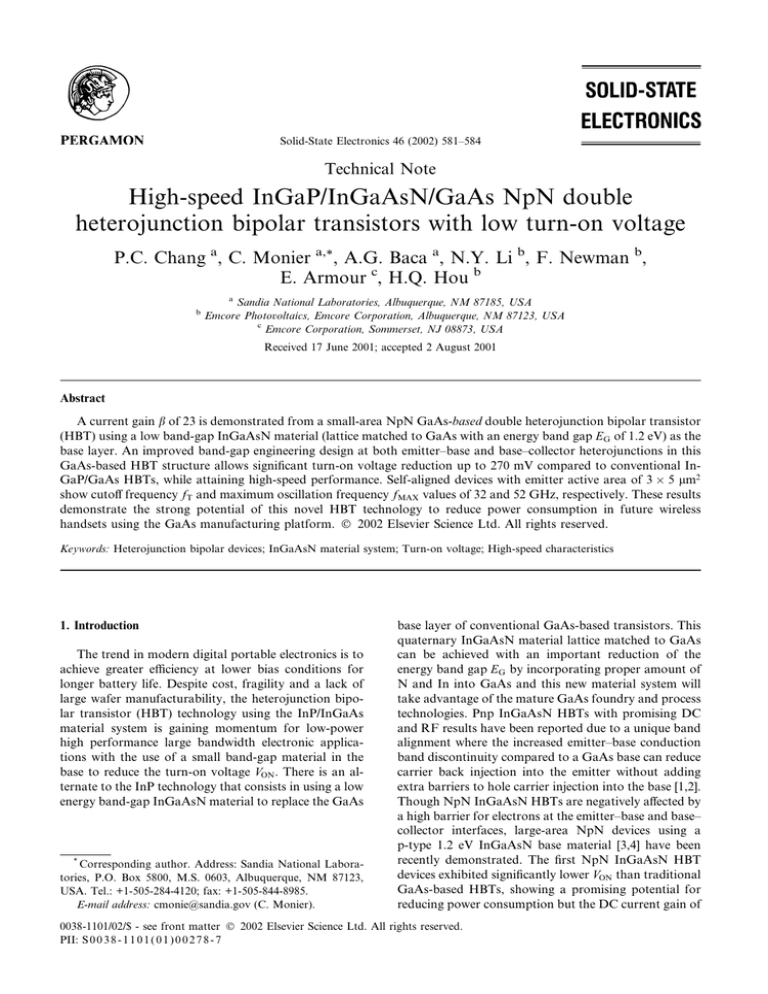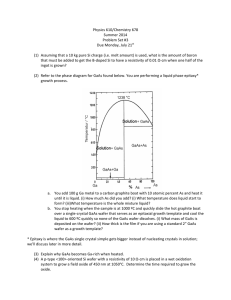
Solid-State Electronics 46 (2002) 581–584
Technical Note
High-speed InGaP/InGaAsN/GaAs NpN double
heterojunction bipolar transistors with low turn-on voltage
P.C. Chang a, C. Monier a,*, A.G. Baca a, N.Y. Li b, F. Newman b,
E. Armour c, H.Q. Hou b
b
a
Sandia National Laboratories, Albuquerque, NM 87185, USA
Emcore Photovoltaics, Emcore Corporation, Albuquerque, NM 87123, USA
c
Emcore Corporation, Sommerset, NJ 08873, USA
Received 17 June 2001; accepted 2 August 2001
Abstract
A current gain b of 23 is demonstrated from a small-area NpN GaAs-based double heterojunction bipolar transistor
(HBT) using a low band-gap InGaAsN material (lattice matched to GaAs with an energy band gap EG of 1.2 eV) as the
base layer. An improved band-gap engineering design at both emitter–base and base–collector heterojunctions in this
GaAs-based HBT structure allows significant turn-on voltage reduction up to 270 mV compared to conventional InGaP/GaAs HBTs, while attaining high-speed performance. Self-aligned devices with emitter active area of 3 5 lm2
show cutoff frequency fT and maximum oscillation frequency fMAX values of 32 and 52 GHz, respectively. These results
demonstrate the strong potential of this novel HBT technology to reduce power consumption in future wireless
handsets using the GaAs manufacturing platform. Ó 2002 Elsevier Science Ltd. All rights reserved.
Keywords: Heterojunction bipolar devices; InGaAsN material system; Turn-on voltage; High-speed characteristics
1. Introduction
The trend in modern digital portable electronics is to
achieve greater efficiency at lower bias conditions for
longer battery life. Despite cost, fragility and a lack of
large wafer manufacturability, the heterojunction bipolar transistor (HBT) technology using the InP/InGaAs
material system is gaining momentum for low-power
high performance large bandwidth electronic applications with the use of a small band-gap material in the
base to reduce the turn-on voltage VON . There is an alternate to the InP technology that consists in using a low
energy band-gap InGaAsN material to replace the GaAs
*
Corresponding author. Address: Sandia National Laboratories, P.O. Box 5800, M.S. 0603, Albuquerque, NM 87123,
USA. Tel.: +1-505-284-4120; fax: +1-505-844-8985.
E-mail address: cmonie@sandia.gov (C. Monier).
base layer of conventional GaAs-based transistors. This
quaternary InGaAsN material lattice matched to GaAs
can be achieved with an important reduction of the
energy band gap EG by incorporating proper amount of
N and In into GaAs and this new material system will
take advantage of the mature GaAs foundry and process
technologies. Pnp InGaAsN HBTs with promising DC
and RF results have been reported due to a unique band
alignment where the increased emitter–base conduction
band discontinuity compared to a GaAs base can reduce
carrier back injection into the emitter without adding
extra barriers to hole carrier injection into the base [1,2].
Though NpN InGaAsN HBTs are negatively affected by
a high barrier for electrons at the emitter–base and base–
collector interfaces, large-area NpN devices using a
p-type 1.2 eV InGaAsN base material [3,4] have been
recently demonstrated. The first NpN InGaAsN HBT
devices exhibited significantly lower VON than traditional
GaAs-based HBTs, showing a promising potential for
reducing power consumption but the DC current gain of
0038-1101/02/$ - see front matter Ó 2002 Elsevier Science Ltd. All rights reserved.
PII: S 0 0 3 8 - 1 1 0 1 ( 0 1 ) 0 0 2 7 8 - 7
582
P.C. Chang et al. / Solid-State Electronics 46 (2002) 581–584
5 suffered from non-optimized electron transport. This
work reports improved DC performance as well as
RF characterization of small-area NpN InGaP/InGaAsN/GaAs double heterojunction bipolar transistors
(DHBTs). Particular attention is given to interfaces with
improved band-gap engineering of the double heterostructure to minimize the effect of conduction band
spikes for improved DC current gain and turn-on voltage reduction.
2. Material and fabrication
There is much interest recently in nitrogen-containing III–V compound semiconductors. The EG of GaAs
is reduced as In is incorporated, while a compressive
strain develops. On the other hand, by adding N into
GaAs, a tensile strain develops, while the EG is further
reduced. By incorporating proper amount of In and N
into GaAs, InGaAsN lattice matched to GaAs can be
obtained and the new quaternary material would have
almost all of its EG reduction in the form of larger
conduction band offset, resulting in better electron
confinement very suitable for optoelectronic devices
[5–7].
Because the InGaAsN material is usually p-type with
a background concentration of mid-1017 cm3 , a low
doped n-type GaAs layer is chosen as the collector
forming a double InGaP/InGaAsN/GaAs HBT structure. The resulting band alignment of this double heterostructure with abrupt interfaces is shown in Fig. 1.
The GaAs collector will allow this device to take advantage of the larger EG of GaAs and lower doping
design for better breakdown voltage characteristics. The
structure grown by metal organic chemical vapor deposition (MOCVD) on semi-insulating GaAs substrates
Fig. 1. Band line-up of a double InGap/InGaAsN/GaAs
abrupt heterojunction.
nþ -GaAs sub-collector followed by
consists of a 5000 A
n-GaAs collector, a 700 A
pþ -In0:03 Ga0:97 a 5000 A
As0:99 N0:01 base (lattice matched to GaAs with an EG of
n-InGaP emitter.
approximately 1.2 eV) and a 500 A
Several design techniques have been employed to optimize electron injection from the emitter and transport
across the base. A d-doping inserted near the base–
emitter junction reduces the spike in the conduction
band (the abrupt InGaP/InGaAsN interface is characterized by a large conduction band offset DEC of 0.32
eV), yielding a lower turn-on voltage of the transistor. A
strained In0:2 Ga0:8 As step-grading layer and a
300 A
second d-doping layer are implemented to diminish the
current blocking effect at the base–collector interface
that prevented electrons from being injected into the
collector in an earlier report [3]. The DEC of 0.20 eV
for an abrupt InGaAsN/GaAs interface is lowered to
approximately 0.03 eV with a graded heterojunction.
The MOCVD precursors were trimethylindium (TMIn),
trimethylgallium (TMGa), phosphine (PH3 ), arsine
(AsH3 ), and 1,1-dimethylhydrazine (DMHy). Selfaligned DHBTs were fabricated using a regular triplemesa technology process. Pt/Ti/Pt/Au and Ge/Au/Ni/Au
were e-beam evaporated to form the base and collector
contacts, respectively, while sputtered WSi served as the
emitter metal. A traditional InGaP/GaAs NpN single
HBT device was fabricated to provide a direct comparison of transistor performance.
3. Device performance
The Gummel plot characteristics of passivated devices with an active emitter area of 3 5 lm2 are shown
in Fig. 2. The DC peak current gain b is 23 at a collector
current density JC of 90 kA/cm2 . Despite improved
Fig. 2. Gummel plot characteristics of a self-aligned 3 5 lm2
NpN InGaP/InGaAsN/GaAs DHBT.
P.C. Chang et al. / Solid-State Electronics 46 (2002) 581–584
Fig. 3. Comparison of collector current for the InGaAsN
DHBT with that of a traditional GaAs HBT (with equivalent
active emitter area of 3 5 lm2 ). The inset shows the common
emitter characteristics of the InGaAsN DHBT (IB step ¼
5 lA).
band-gap engineering at interfaces to reduce current
blocking effect, difficulties in producing electron mobility and lifetime values in the base comparable to the
GaAs counterpart lead to non-optimized base transit
time and significant base current for a reduced DC
current gain compared to InGaP/GaAs HBTs. The
collector ideality factor nC is 1.05 and the base ideality
factor nB is 1.15 indicating a high quality of the InGaP/
InGaAsN and InGaAsN/GaAs heterojunctions. The
turn-on voltage (defined as the base–emitter voltage required to exceed a determined collector current density)
of the NpN InGaAsN DHBTs is about 220 mV lower
than in the conventional NpN InGaP/GaAs HBT, as
shown in Fig. 3. The low turn-on voltage VON (lower
than previous attempts [4,8]), associated with an offset
voltage VOFFSET 0:10 V and a knee voltage VKNEE 0:35 V provides an initial indicator of the promising
potential this novel technology can have for reducing
power dissipation in GaAs-based transistors. Reducing
the device operating voltage is a key requirement for
maintaining the GaAs-based technology attractive for
future wireless applications. Microwave measurements
have been performed with a HP-8510C network analyzer. Fig. 4 shows the small-signal current gain h21 and
the unilateral gain U measured on wafer from small-area
InGaAsN DHBTs. Self-aligned devices having a total
emitter area of 3 5 lm2 exhibit a cutoff frequency fT ¼
32 GHz currently limited by the base transport parameters. The nitrogen incorporation (1%) required to
reduce the energy band gap down to EG ¼ 1:2 eV for
significant turn-on voltage reduction is associated with
degraded carrier transport properties across the base
583
Fig. 4. Small-signal current gain h21 and unilateral power gain
U of a 3 5 lm2 NpN InGaP/InGaAsN/GaAs DHBT.
compared to a structure with a control GaAs base layer.
Despite a base sheet resistance around 1000 X/, a
maximum oscillation frequency fMAX of 52 GHz is observed. Such a high base resistivity is due to much lower
majority carrier mobility in p-type InGaAsN compared
to GaAs. These encouraging high-frequency characteristics were obtained using straightforward epitaxial
design and processing techniques. Improvements are
expected by means of more aggressive base designs and
fabrication methods in order to diminish the base transit
time (by grading the base doping profile) and reduce the
base–collector capacitance (through reasonable laterally
etched undercut of the collector region).
4. Conclusion
MOCVD-grown high-speed NpN GaAs-based
DHBTs with the use of a low energy band-gap InGaAsN material (EG 1:2 eV) as the base layer have been
successfully fabricated with improved emitter–base and
base–collector heterojunction interface designs by combining d-doped and step-graded layers for a useful DC
current gain b of 23. A turn-on voltage 220 mV lower
than that of InGaP/GaAs HBTs indicates the strong
potential of the InGaAsN HBT technology to achieve
greater efficiency at lower bias conditions. Good RF
performance of this novel HBT is reported with measured cutoff frequency of 32 GHz and maximum oscillation frequency of 52 GHz. This technical progress
should benefit to RF circuits using GaAs-based HBTs
by reducing the operating voltage for lower power
consumption and better management of supply voltages
in advanced wireless handsets.
584
P.C. Chang et al. / Solid-State Electronics 46 (2002) 581–584
Acknowledgements
Sandia is a multi-program laboratory operated by
Sandia Corporation, a Lockheed Martin Company, for
the United States Department of Energy under contract
DE-AC04-94AL85000.
References
[1] Chang PC, Li NY, Monier C, Baca AG, LaRoche JR, Hou
HQ, et al. Electron Dev Lett 2001;22:113–5.
[2] Monier C, Baca AG, Chang PC, Li N, Hou HQ, Ren F,
et al. Electron Lett 2001;37:198–9.
[3] Li NY, Chang PC, Baca AG, Xie XM, Sharps PR, Hou
HQ. Electron Lett 2000;36:81–3.
[4] Chang PC, Baca AG, Li NY, Xie X, Hou HQ, Armour E.
Appl Phys Lett 2000;76:2262–4.
[5] Kondow M, Uomi K, Niwa A, Kitatani T, Watahiki S,
Yazawa Y. Jpn J Appl Phys Part 1 1996;35:1273–5.
[6] Choquette KD, Klem JF, Fischer AJ, Blum O, Allerman
AA, Fritz IJ, et al. Electron Lett 2000;36:1388–90.
[7] Steinle G, Medere F, Kicherer M, Michalzik R, Kristen G,
Egorov AY, et al. Electron Lett 2001;37:632–4.
[8] Welser RE, DeLuca PM, Pan N. Electron Dev Lett
2000;21:554–6.


